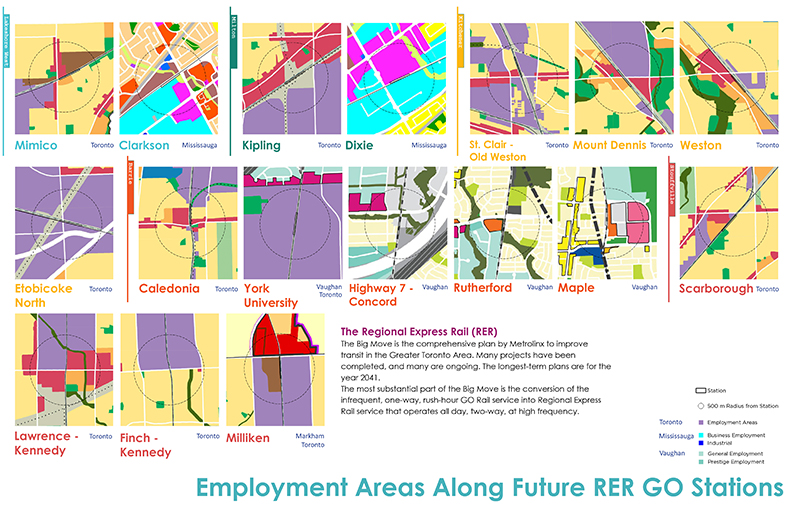Is it Time to Abolish Employment Lands?
During the COVID-19 pandemic, people’s relationships with their cities and neighbourhoods shifted. Those fortunate enough to have jobs that could support remote work left their offices and began working from home. For many, this resulted in more time spent in their local area than ever before. During the pandemic disruption, people walked and cycled more, commuted less, and engaged in local lifestyles.
As an urban planner, I’ve been interested to see how this trend would transition into post-pandemic life. Now that we’ve re-emerged from lockdowns and stay-at-home orders, we’re seeing how organizations are establishing workplaces of the future. Many companies have said that remote work is here to stay. Others have adopted a permanently hybrid in-person and at-home arrangement.
This phenomenon begs the question: why do we continue to prioritize land that is exclusively used for employment purposes? Furthermore, is it time to abolish employment lands altogether in favour of mixed-use development?

Employment Lands
Employment lands are areas in a city’s official plan that are reserved for economic or business activities. Historically, they have been sites for manufacturing and industrial uses, but can contain any commercial activity. Housing is forbidden in areas zoned Employment.
Toronto’s Official Plan defines two types of employment zones: core and general. Core employment areas tend to contain industrial land uses. They are usually found at the centre of employment areas. General employment areas are typically found surrounding core employment and contain a wide variety of commercial land uses. In general employment areas, you might find restaurants, retail, and other commercial services.
While some of Toronto’s employment lands continue to support manufacturing, the economic shift toward knowledge-based production rather than physical production has made manufacturing space less lucrative. Still, the City of Toronto and Province of Ontario like to protect employment lands as if the local economy hasn’t changed since the mid-twentieth century.
13.6% of Toronto’s land area is designated Employment, and more than a quarter of jobs in the city are found in these areas. As a result, the City and Province argue that these lands are vital for economic productivity and shouldn’t evolve to accommodate other uses.
Check out my mini-webinar: How to Develop Toronto’s Employment Lands to learn more.
Transitioning to Mixed-Use
As an urban planner, segregating land uses in 2022 just doesn’t make sense to me. While I agree that industrial activities probably shouldn’t take place next to someone’s home, I don’t see any reason why general employment areas cannot coexist with residential uses.
As we saw during the height of the pandemic – more walking and biking, and less commuting – the local lifestyle became more important than many people had considered before. Evolving employment lands to accommodate mixed-use development can facilitate the complete communities that we desire, where services, workplaces, and community spaces are all accessible in close proximity to home. During post-pandemic times, do people really want to sit in traffic or ride a train for an hour, just to reach a far-away office space?
Another good reason for abolishing employment lands is the ongoing housing affordability crisis. We need to increase housing supply to offer more homes for more people. One of the ways to do this is to unlock restrictive land uses for residential uses. Employment lands are the perfect place to start. By building mixed-use communities on these underperforming sites, new residents can experience vibrant lifestyles in walkable and transit-oriented areas, and we can advance a mission of building more housing in the City.
What’s more, many of Toronto’s employment lands are located along rail corridors. By unlocking these lands for housing development, we can create transit-oriented communities to reduce auto-reliance and connect neighbourhoods on existing transit routes.
It’s Time to Evolve
Developers have their eyes on employment lands. Given high-demand for new housing developments, there has been an uptick in employment land conversion requests in Toronto and surrounding areas. How many of these applications will be approved? It’s hard to know. It’s an uphill battle to transition areas zoned Employment to allow for housing, but that doesn’t mean it isn’t worth trying.
It’s true that we need space for employment purposes and economic activities, however, existing employment land in the City is primarily characterized by low-rise buildings and surface parking lots. This is simply an inefficient use of space and unrealized potential.
Toronto has a tremendous opportunity to respond to the housing crisis, advance its goals for transit-oriented communities, and build neighbourhoods that support post-pandemic lifestyles by unlocking employment lands. COVID-19 disrupted our lives in so many ways. We learned that we can do things differently. Let’s maintain that same spirit as we plan for land-uses for walkability, transit use, and smarter density that will define our City for years to come.
We are proud to introduce Planning for Non-Planners!
